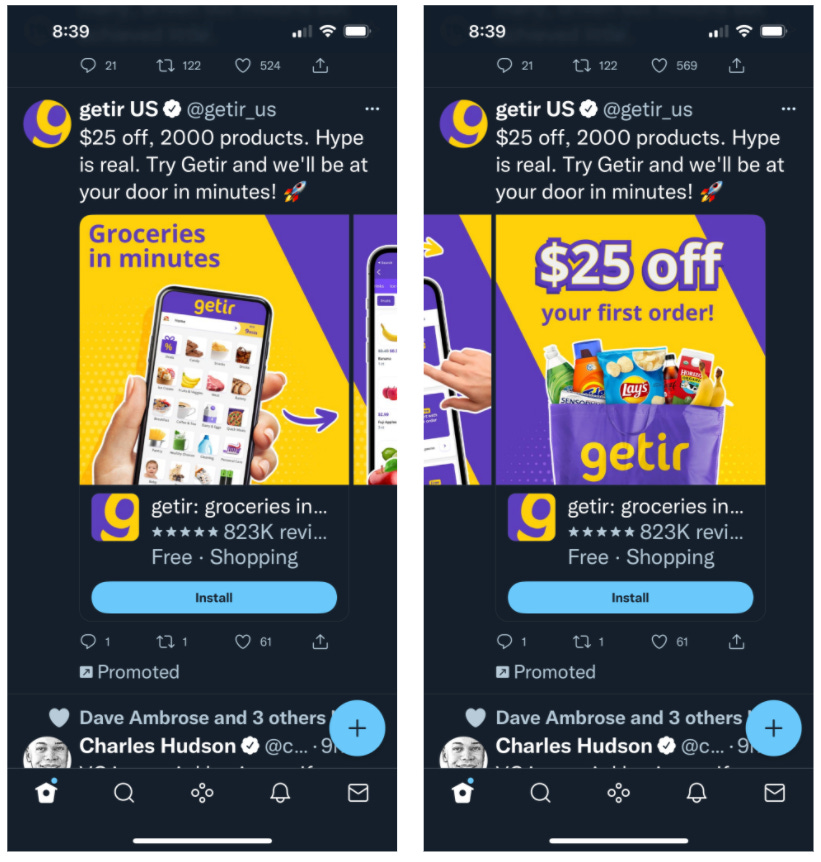#117 - The Walking Dead
An Update on Ultrafast Grocery Delivery
Hi 👋 - 2022 has been a brutal year for unprofitable tech stocks. Many are trading 25-50% below recent highs. The carnage hasn’t yet filtered into the private markets. Earlier in March, ultrafast grocery delivery startup Getir turned heads when it raised a Series E at a nearly $12 billion valuation. Today, a look at Getir’s business model, DoorDash and Uber’s grocery aspirations, and comings and goings in the ultrafast delivery market. Thanks for reading.
🛍 If you’re finding this content valuable, consider sharing it with friends or coworkers.
🛍 For more like this once a week, consider subscribing.
Getir: What, Me Worry?
Getir was founded in 2015 in Istanbul by Nazim Salur, an entrepreneur who also started BiTaksi, a Turkish ride-hailing app. Since then, it’s built a strong European presence, operating in France, Germany, Italy, Portugal, the Netherlands, and Turkey. It entered the crowded US market in late 2021 in Boston, Chicago, and New York.
Getir’s business model is similar to other ultrafast grocery delivery start-ups like GoPuff or JOKR. It’s vertically integrated, owns inventory, and peppers cities with micro-fulfillment centers (MFCs) offering limited SKUs (about 1,500 per MFC) focused on everyday needs and high frequency categories like eggs and toilet paper. Salur sees vertical integration as critical to providing speedy delivery. Globally, Getir has over 32,000 employees, including its delivery drivers. Salur trumpets offering drivers better working conditions versus gig companies like DoorDash and Uber. It’s a low bar. By “better working conditions,” he means providing drivers access to a bathroom, a place to sit, and coffee or tea1.
While unprofitable tech stocks have been in the crosshairs the past six months, Getir has been Teflon (for now). Over the past year, its valuation has skyrocketed from $2.6 billion to nearly $12 billion. In June 2021, it raised a $550 million Series D at a $7.5 billion valuation. In March 2022, it raised a $768 million Series E led by Mubadala Investment Company, with participation from Abu Dhabi Growth Fund, Alpha Wave Global, Sequoia, and Tiger Global, at a valuation of $11.8 billion. That’s the same ballpark as Wayfair’s market cap despite the fact that in 2021, Wayfair generated $13.7 billion in revenue, $2.9 billion of gross profit, and had over 27 million active customers.
With its coffers full, Getir is in full land-grab mode. Sular sees ultrafast grocery delivery growing into a massive industry and expects billions of additional dollars to be invested into the space. To him, the key question is whether this capital will be split between 20 to 30 players or it will go to just a few2. He’s betting on the latter and wants Getir to be the last man standing.
Now flush with cash, Getir is playing a different game than it was a few years ago. It raised $38 million in 2020 versus over $1 billion in the past twelve months3. Deploying tens of millions of dollars well is different from blitzscaling with hundreds of millions of dollars. Growing fast creates its own headaches. When everything is turned up to eleven, mistakes get amplified. The Notorious BIG said it best, mo money, mo problems.
In interviews, Salur is demure about sharing certain operational details, given that Getir is competing with over 20 different clones4. The current ultrafast delivery situation feels like the early days of Groupon and daily deals: lots of capital, lots of competition, little discernible competitive advantage or differentiation aside from the colors the couriers wear: purple and yellow for Getir, light blue for GoPuff, hot pink for Buyk.

Profitability is notoriously difficult to attain in delivery. Ultrafast delivery is even harder as the atomic unit of demand is the neighborhood. Whereas Uber and Lyft expanded city by city, ultrafast grocery delivery providers battle it out block by block. Perhaps that’s why Salur is coy about discussing profitability. While he notes that it takes six months for a MFC to mature and that Getir could be profitable today if it wasn’t focused on growth, financial disclosures are scant5.
One metric that Getir discloses is app downloads. Eyeroll. In 2021, Getir had 3.4 million active users and 34 million cumulative app downloads6. In March 2022, it had 40 million app downloads7. App downloads are a vanity metric, particularly for a company with aggressive first order promotions. In general, app downloads are a function of the amount of capital you’ve raised (Getir has raised a lot) and the constraints (or lack thereof) on your marketing team. More useful metrics would shed light on what these app users are doing. For example, retention rates, purchase frequency, and average order value. A business can buy app downloads, but it needs to earn the trust required for repeat purchases that drive LTV.
No one brand dominates the grocery market globally. Salur sees ultrafast delivery as following a similar progression, with two or three large players in each market8. At a nearly $12 billion valuation, Getir is priced as if it’s going to be one of the leading layers in a large, profitable industry. There are a lot of ifs baked into that price.
Getir is already consolidating the ultrafast delivery market by acquiring Block in Spain and Weezy in the UK. Still, DoorDash, Lyft, and Uber show that scale and consolidation is no panacea for profitability. As Warren Buffett puts it:
When a management with a reputation for brilliance tackles a business with a reputation for bad economics, it is the reputation of the business that remains intact.
Watch Your Back
Getir isn’t the only one with money to burn on marketing. DoorDash and Uber are investing heavily in grocery and convenience delivery. For example, Uber Eats ran a Super Bowl ad highlighting non-restaurant delivery featuring big names like Gwyneth Paltrow, Trevor Noah, and Cousin Greg from Succession.

Uber has been building its delivery business since 2014, supplementing organic investments with acquisitions like Cornershop (grocery delivery) in 2019, Postmates (food delivery) in 2020, and Drizly (alcohol delivery) in 2021. These acquisitions form the nucleus of Uber’s new verticals delivery business, which encompasses everything that doesn’t come from a restaurant.
In Q4 2021, new vertical bookings hit a $4 billion run rate, growing 10% quarter-over-quarter, and accounting for 7% of total delivery bookings. About 12% of Uber’s monthly active users have ordered from a new vertical. Unlike Getir, Uber hasn’t been shy about delivery profitability. Here’s Uber’s CEO Dara Khosrowshahi on the Q4 earnings call9:
Delivery reached an important milestone in Q4, generating $25 million in segment-adjusted EBITDA and marking the first profitable quarter of many to come. And as I said on our last call with you, we view the turn to EBITDA profitability as a big moment but ultimately just a step along the way to creating a self-sustaining and incredibly valuable business. With this milestone accomplished, Delivery is well positioned to self-fund growth in grocery, retail and local commerce. And let me underscore, we expect significant EBITDA profit generation even after those investments.
Uber is also experimenting with ultrafast delivery, but its approach is focused on partnerships. It has inked deals with GoPuff in the US and Carrefour in France.
DoorDash has also been successful expanding beyond restaurant delivery. In Q4 2021, 14% of its 25 million monthly active users shopped in a category outside of restaurants. Additionally, it doubled the number of non-restaurant merchants on the marketplace in 202110.
While Uber’s is partnering with ultrafast delivery services, DoorDash is building its own infrastructure. In August 2020, it launched DashMart, the dark store equivalent of a 7-Eleven. DashMarts are virtual convenience stores selling snacks, groceries, and other high purchase frequency items. They’re owned, operated, and merchandised by DoorDash, putting them in direct competition with Getir and GoPuff.

On its Q4 2021 earnings call, DoorDash CEO Tony Xu highlighted growing DashMart demand and a long investment time horizon11:
If you think about all the other products and services that merchants need to build in order to compete digitally in today's economy, well, it certainly expands far beyond just logistics. And so DashMarts are really a form of infrastructure to store inventory to possibly enter new geographies and certainly expand their hours of service. And so we plan on investing in this line of work for a really long time for those reasons…But again, the investment philosophy stays the same, given how young DashMarts are, it's making sure that we have great product market fit and then we'll continue to scale them.
DoorDash’s investment philosophy is sensible: establish product-market fit, then scale. Instant grocery delivery startups are doing the opposite: establish scale, then look for product-market fit. Billions of venture capital open up the fake-it-until-you-make-it playbook.
Lightning Round
DoorDash and Uber have large balance sheets, liquid public currencies, and the ability to weather sustained periods of unprofitability and cash burn. Both are likely to be going concerns in five years. That can’t be said about many of the 20 plus ultrafast delivery upstarts. Some will be acquired, some will run out of cash and go belly up. This is already happening:
1520 shutdown in December 2021 after running out of cash.
Buyk, a US subsidiary of Samokat, a Russian delivery startup, declared bankruptcy in March as sanctions restricted access to funding. Sanctions likely accelerated the inevitable.
Fridge No More, also backed by Russian investors, found itself in the same sinking boat as Buyk.
Gorillas dropped its 10 minute delivery pledge. Slower delivery speeds would reduce the number of delivery drivers needed, helping reduce costs.
GoPuff, with a paper valuation of $40 billion is struggling to find secondary investors willing to buy shares at valuations as low as $15 billion. The company is also rumored to be eyeing a 2022 IPO. Given the public markets are unforgiving of unprofitable tech right now, GoPuff’s S1 might get a WeWork like reception.
JOKR is looking to sell its New York City business, which has bled cash since launching June 2021. (Presumably it’s looking for a multiple on its app downloads.) JOKR’s investors are urging the company to focus on its business in Latin America where competitive intensity and labor costs are lower.
Instacart is joining the ultrafast delivery fray. In an attempt to fend off both Amazon and start-ups like Getir, the company will start building MFCs and offering 15 minute delivery. Instacart is piloting ultrafast delivery in partnership with grocer Publix in Atlanta and Miami.
Citing market turbulence and poor market conditions for tech stocks, on March 24th Instacart cut its valuation by 38% from $39 billion to $24 billion (or roughly two Getirs)12. For ultrafast delivery start-ups, Instacart’s haircut is a harbinger of what’s to come.
🛍 If you’re finding this content valuable, consider sharing it with friends or coworkers.
🛍 For more like this once a week, consider subscribing.
More Good Reads
Petition’s overview of ultrafast delivery. The BBC on the rise of ultrafast grocery delivery. VC20 interview with Getir founder Nazim Salur. Below The Line on GoPuff and JOKR.

Petition, 🔥"Instant Needs": How Much $ Will Go Puff?🔥, February 16, 2022.
Rest of World, U.S. could be a retail “graveyard” for ultrafast delivery app Getir, analysts say, February 14, 2022.
Techcrunch, Getir is now worth nearly $12 billion after raising another $768 million, March 17, 2022.
Uber, Q4 2021 Earnings Call, February 9, 2022.
DoorDash, DoorDash Q4 2021 Earnings Call, February 16, 2022.
DoorDash, DoorDash Q4 2021 Earnings Call, February 16, 2022.
The New York Times, Instacart Cuts Its Valuation by 38 Percent in Not to ‘Turbulence’, March 25, 2022.




"Getir could be profitable today if it wasn’t focused on growth, financial disclosures are scant" - Reminds me of WeWork, lol.
I saw Getir all over the place in London.